05.14.2009 | 10:26 am
I am often asked by people who know less than I, “How can I look back when riding my bike?”
Well, as an extremely fast, fit, and award-winning cyclist, I personally never have any need to look back when riding my bike. Once I have passed something, there is no possibility that it will ever pose a threat again. And frankly, whatever I have passed disappears into a point on the horizon so quickly that there’s really no value in looking back, anyway.
However, I am sympathetic to your plight.
Why You Would Want to Look Behind You
Before explaining how to look behind you, we need to consider why you might want to look behind you. As an average cyclist, there are three excellent reasons:
- To see the vehicle that is bearing down on you. Actually, I was only joking. This really isn’t a good reason for looking behind you. If a vehicle is bearing down on you, it will either miss you or it won’t. And it doesn’t help to try to quickly memorize the license plate, either. My experience shows that if the vehicle hits you, you won’t remember the moments before the accident anyway.
- To see the vehicle that is honking at you. I’m joking again, of course! If a vehicle is honking at you, that’s because it’s full of teenagers, and they’re playing a hilarious practical joke on you. Ho ho! If you look back, you are validating their wittiness, but not to the full extent they are hoping for. Ideally — for them — you will swerve and fall. Or, if you choose to be non-compiant with their joke, you can instead acknowledge them with a gesture of your choosing (such as a big “thumbs-up” and a smile, as if you were both in a Mentos commercial).
- To assess whether another cyclist is catching up to you. This, naturally, is the real reason you might want to look behind you.
The Problems
Sadly, looking behind you is not as simple as craning your neck around and taking a gander (especially if you’re over 40 and you can no longer turn your head more than thirty degrees in either direction).
For one thing, as you have likely noticed, when you twist your body and turn your head to see what’s behind you, you stop being a cyclist…and become a drunken menace to all and sundry, swerving sharply in the direction you are turning your head as if a U-turn is absolutely imperative right this very second.
More importantly, however, is the fact that by turning your body and head to look behind you, you have tipped your hand. You have just alerted the people behind you that you are worried about them catching up. That you even admit the conceivability of the notion of the theoretical possibility that they might catch up.
And in short, you have shown weakness. “I am about to crack,” is the message you have just telegraphed. “Attack now.”
This will not do.
You need to learn to look back correctly. And I am about to tell you how.
The Basics
When you are first learning how to look back, you should stick to the essentials: finding out how close behind you your opponents riding buddies are, without killing all of you by swerving into traffic or a curb. Worry about being stealthy later.
The trick is simple, and so I’m tempted to make it a little more complicated than it actually is, so as to impress you with my knowledge of the arcane. But I won’t. Because I care about you.
[Note: I am generally reluctant to give actual useful advice, but am making an exception here]
As you turn your head and body to look back, also lift your arm so it’s pointing in the direction you want to look, and you won’t swerve.
That’s it. That’s the whole thing.
However, you may want to jazz it up by making your hand into the pistol shape and doing the “shooting” action with your thumb while winking to the people behind you, as if you were — instead of checking to see if you will be overtaken soon — are giving them a jaunty and perhaps mildly creepy greeting.
Advanced Techniques
Most expert cyclists will not be fooled by this tactic (Chris Horner is a notable exception; he falls for the “point and shoot” gambit every time). To check behind you with more stealth, you need to become with more arcane techniques.
The most effective and desirable way to check to see if anyone is behind you is to check your shadow. Provided the sun is behind you and low in the sky, you can simply look down. Then use this handy guide to tell whether you are about to be overtaken:
- If you see 1 shadow, of course you will naturally panic, thinking that you are about to be overtaken. Relax! That shadow is yours. You are doing just fine.
- If you see 2 shadows, then you are in fact about to be overtaken. Stand up and sprint as if your life depended on it.
- If you see 2 shadows and one of them is 14 feet tall and six feet wide, then you are about to be overtaken by the chupacabra. Stand up and sprint as if your life depended on it. Because it does.
[Note: My legal counsel advises that it is also possible that if you see a 14-feet tall, six-feet-wide shadow, it may be a car in the late afternoon. In which case I still advise sprinting as if your life depended on it, because the chupacabra may be inside the car.]
The second-best way to check behind you is to glance as you go around a switchback. This gives you an excellent opportunity to see how far behind you your mortal enemies friends are. I am personally very partial to this technique, and so will only ride — road or mountain — where there are plentiful switchbacks.
Sadly, the switchback technique and the shadow technique are not very effective when used in combination, primarily because switchbacks have the unfortunate effect of reversing your direction every so often. This makes it devilishly difficult to keep the sun at your back.
For this reason, the third technique — the spit-glance – has been developed. To do the spit-glance, turn your head far to the left (or, in Australia, to the right) and spit down. As you do this, wrench your eyeballs as far back as you can, stealing a glance behind you. You have no more than a tenth of a second to take in your rear view before being detected, so don’t dawdle.
As a bonus, if you use this technique often enough, people will become quite wary of riding behind you and will think long and hard before passing (Hi, Dug!).
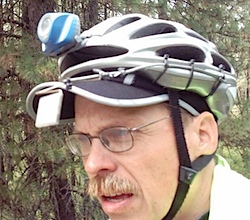 Things to Avoid
Things to Avoid
Really, I only have one thing to avoid, but the heading “Thing to Avoid” seemed awkward. So: the thing to avoid as you develop your surreptitious looking-back skills is: purchasing a mirror.
Yes, I know. Those mirrors work. They work great in fact. But don’t use them.
“Are you talking about helmet- or handlebar-mounted mirrors?” is the question I expect you are about to ask.
The answer is, “Yes.”
“But why not?” is your question.
“Please refer to the photograph,” is my answer (Hi, Kent!).
[Note: The "Things to Avoid" section (see above) does not apply to recumbent riders. In fact, I believe that recumbents are required by law -- or at least by whatever mad impulse it is that drives a person to recumbents -- to have both a helmet mirror and a handlebar mirror. ]
Yes, the art of looking back on a bicycle is a complex, multifaceted technique, requiring no small amount of determination. Once you have invested the necessary years of practice, however, I guarantee you will always know who is about to pass you.
I wish you luck.
Comments (48)
05.13.2009 | 11:05 am
I don’t have anything clever to say about bicycles today.
Wait. That was far too specific. I should have said, “I don’t have anything clever to say today.” No need to narrow it down to bikes.
But I have my reasons. And I’m going to subject you to that set of reasons right now.
I apologize in advance.
Chirp
It is a scientific fact that no battery on any smoke alarm ever runs out of juice except between the hours of 3:00 and 4:30 AM. Say, for example, it’s a battery’s time to go, and it’s only 11:00 PM. All of the other batteries in the world will get together and concentrate very hard, lending good vibes and energy and willpower to that on-last-legs smoke alarm battery, giving it the strength it needs to hold on ’til 3:00 AM.
And so, at 3:00 AM — on the nose — this morning, I was wakened by a chirp.
Then, at 3:00:30 AM, I was awakened by another chirp.
At 3:01 AM, I was awakened by another chirp. This time, I was sufficiently awakened that I recognized the chirp for what it was. “Well, it’s 3:00 AM,” I thought. “This seems like the perfect time for me to go on a scavenger hunt for a 9-volt battery, followed by a game of chirping-smoke-alarm Marco Polo.”
I trudged petulantly to the fridge. And I’m dead serious about the petulance of my trudging. If you had seen me trudge, you would have been astonished at how effectively I can communicate petulance with mere footsteps.
The reason I went to the fridge, of course, was to see if there were any 9-volt batteries in it.
There were. Ten of them, still in their original packaging.
[Quick Aside: I'm pretty sure it's fairly common practice for people to keep new batteries in the fridge. Am I correct in that? Also, is there any basis to the conventional wisdom that batteries keep longer if refrigerated? Has there been a Mythbusters episode on that? It almost doesn't matter to me, because I have kept new batteries refrigerated ever since I've owned a fridge and like the fact that I always know where the batteries are, regardless of whether this is actually helpful (or maybe it's actually even harmful?) to the useful life of the battery.]
I spent four minutes grappling with cellophane, then started listening to the chirp in earnest.
Where could it be?
First Attempt
From the relative softness of the chirp and from the fact that I don’t like to go into the basement at night because it’s really cold down there, I decided the chirp was coming from upstairs. I trudged (petulantly, still) to the top of the stairs, then waited for the chirp.
And so the fire alarm decided it should start taking four times as long between chirps, to make the game of Dead Smoke Alarm Battery Marco-Polo more challenging.
Eventually, the chirp came, from the left. I went and stood under the smoke alarm at the end of the hall, gazing up at it, expectantly, thinking to myself, “I cannot think of a single thing I would rather be doing right now.”
The chirp came again. Right from up there. I had guessed right the first time.
Unbelievable.
I dragged a chair from what I lovingly call “The Roller Room.” I have named the room thusly because that’s where my rollers are. It’s also where Susan’s jewelry and craft equipment is kept, and the rest of the family calls it “the craft room,” but I’ll be damned if I’m going to tell anyone that “I’m headed up to the craft room for a couple hours.”
Anyways.
In a moment I had pulled out the old battery and put in the new one. I then dragged the chair back into The Roller Room, and started walking back down the stairs.
And then I heard the chirp again.
Second Attempt
I pivoted, halfway down the stairs, and walked back up, upgrading my emotive level of trudginess to “put upon.” I then stood under the hallway alarm ’til I heard the chirp again.
No, that chirp was definitely not coming from the hallway smoke alarm.
I trudged — perfecting my put-upon trudge technique — downstairs, opened the fridge, got another 9-volt battery (taking a moment to be glad that I had started with more than one 9-volt in the fridge), and went back upstairs.
This time, using my powers of deduction — it couldn’t be the hall alarm and it shouldn’t be the twins’ alarm because I remember changing it fairly recently — I deduced it ought to be The Roller Room alarm.
Plus, I liked the fact that I would only have to drag the chair about eighteen inches to be in the right spot for changing the battery.
I made the swap, did not bother moving the chair back into its correct place, and started heading back downstairs.
And then I heard the chirp again.
Third Attempt
I pivoted and went back upstairs. By now I was pretty well awake and had upgraded my trudge to a peevish march. I stood in the doorway between the hallway and Roller Room alarms, trying to tell which could possibly be the offender.
The chirp told me it was neither.
And that’s when I had a flash of brilliance: we also have a guest room.
You may think it strange that I had until this point completely neglected the possibility that the chirping could be coming from the guest room, but the door to that room is always closed. Nobody goes in except when guests are here, and then only guests go in. Sure, it’s part of the house, but we don’t think about it much.
The guest room door is also very nearly at the end of the hall.
I opened the door just in time to hear a — much louder now, thanks — chirp.
Downstairs I went, to fetch the third battery of the night.
Opening the fridge door, I considered how fortunate it was that we had a whole big-box-store-sized box of 9-volts on hand, since I evidently was in the process of doing stair intervals and changing every smoke alarm battery in the house. At 3:00 AM. Or rather, 3:15, now.
I replaced the battery, this time certain I had changed the right one. I shut the door and started doing my “grateful to be going back to bed at last” walk down the stairs.
And then I heard the chirp again.
Fourth Attempt
I pivoted and went back upstairs. I really was absolutely positive that the smoke alarm in the guest room was the one making the noise, but stood under it until it chirped again to make certain.
Yes, no question about it.
I considered: could the chirp mean not that the battery was dead, but that the alarm was defective? Maybe. Could it mean that there’s a very small fire nearby, one that merited occasional chirping instead of full-on blaring? Maybe. Could it mean that I put the battery in wrong?
Yes. It could definitely mean that.
I got the chair back out of The Roller Room, opened the battery door and looked. No way to tell if it was in wrong from there. I took out the battery and checked.
Yes, that was it. I had put the battery in wrong.
I put the battery back in — this time really thinking it through — and started heading back downstairs.
This time I was almost certain I would hear the chirp again.
But I did not. I had — finally — triumphed.
Afterward
I laid back down, grateful to finally be back in bed.
And then, for the next hour and a half, I contemplated the fact that once one has climbed the stairs half a dozen times (or so) and done no small amount of sleuthing, battery changing, more sleuthing, more battery changing, and then troubleshooting and battery changing, one might arrive at two very important truths. Specifically:
- If one were to use my hallway’s smoke alarm as the center of a six-foot circle, one would find four smoke alarms in that circle (the hallway, the guest room, the Roller Room, and the twins’ room).
- I was now thoroughly awake.
Comments (62)
05.11.2009 | 11:19 pm
A Note for 100 Miles of Nowhere Racers from Fatty: 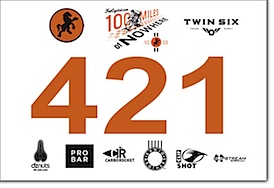 Team Fatty (Philadelphia) member Clay Frost recently observed a glaring problem in the 100 Miles of Nowhere: there are no race bibs. Cleverly, he has had several printed up, and you can get one — even if you’re not actually in the race, which is confusing but cool — for the measly price of $5.00, donated to Clay’s LiveStrong Challenge account. This is a genius idea, frankly, and I hope you’ll get yourself a bib (pictured here) and wear it proudly on race day. And be sure to send me a photo.
Team Fatty (Philadelphia) member Clay Frost recently observed a glaring problem in the 100 Miles of Nowhere: there are no race bibs. Cleverly, he has had several printed up, and you can get one — even if you’re not actually in the race, which is confusing but cool — for the measly price of $5.00, donated to Clay’s LiveStrong Challenge account. This is a genius idea, frankly, and I hope you’ll get yourself a bib (pictured here) and wear it proudly on race day. And be sure to send me a photo.
By the way, you can’t have bib #001. That’s mine, because I — as the only entrant, sure — won last year’s race.
To get your race bib in time for the race, click here to go donate $5 at Clay’s LiveStrong Challenge page. Right now.
As part of your donation, Clay will have your address, so you shouldn’t have to do anything else to get the bib. Thanks!
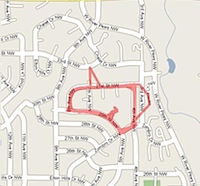 Another Note for 100 Miles of Nowhere Racers: Neil C wins the “Jumping the Gun” award by having already completed the 100 Miles of Nowhere — two weeks before the event actually began. I would like to compliment Neil on his fortitude, his intensity, his speed (almost exactly nine hours), and his apparent ability to bend the rules of space and time.
Another Note for 100 Miles of Nowhere Racers: Neil C wins the “Jumping the Gun” award by having already completed the 100 Miles of Nowhere — two weeks before the event actually began. I would like to compliment Neil on his fortitude, his intensity, his speed (almost exactly nine hours), and his apparent ability to bend the rules of space and time.
Based in Rochester, MN, Neil rode a 0.95-mile neighborhood loop on his Specialized Epic MTB enough 106 times. A 75-foot climb on each lap meant that Neil climbed 8000+ feet during his ride.
Says Neil, “It took until after mile 80 for any of the neighbors I didn’t know to say anything.” And then he warns, “This was extraordinarily boring.”
But in a good way, right, Neil?
Oh, Now I Remember
Every winter, my perception of road cycling somehow gets warped. I’m pretty sure this has to do with all the time I spend on the rollers. After months and months of riding my road bike in place, I somehow start to think that my cumulative distaste for the whole ride-in-place thing includes the bike itself.
Somehow, I manage to think of riding the rollers as the same thing as riding the road.
Thus, by the time good weather arrives (and I have definitely become a fair-weather rider during the past few years), I have no interest at all in taking the road bike out. “Let it stay upstairs with the rollers where it belongs,” I think.
And I ride my mountain bikes, exclusively, for weeks on end.
Eventually, though, there will be some external circumstance that forces me to get out the road bike: usually a hard rain at night, followed by a beautiful morning. Too muddy to hit the dirt, but too perfect a day to not go for a ride.
Oh well. I may as well haul out the ol’ road bike.
Annual Revelation
And then, every year, I rediscover the fact that road bikes are every bit as wonderful as mountain bikes. I would say, in fact, that this annual revelation is emphasized by my low expectations, and what I’ve come to expect a bike to feel like.
Suddenly, I rediscover exactly how smooth a road bike feels. Those hard skinny wheels carve corners with an elegance a mountain bike was never meant to have.
Oh, and the power: compared to a mountain bike, when you pedal a road bike, you just leap forward. The difference is startling, at first. And exquisite.
And then there’s the simplicity I feel when on a good road ride: the focused, clear feeling of doing exactly one thing. It’s not a feeling I get often on mountain bikes.
What’s most amazing to me, however, is that I somehow forget over the winter how incredibly exciting a road ride can be. For the group I ride with at least, mountain bike rides are often social occasions. On the road, however, every ride becomes a race. And then there’s the downhill on a road ride: if you open yourself up to it, it feels very nearly like how I imagine flight must feel.
Lucky
Once I have remembered that I love road riding — somedays more than mountain biking, some days less, but on average just the same. They’re so different, but complement each other so well. I sometimes think about how lucky I am to have discovered both. Or really, to have discovered cycling at all.
The fact that I spend so much time riding bikes, and so much time writing about bikes really makes it obvious, but I still think it’s worth saying once in a while, with no intended comedy or irony, as directly and simply as I can:
Whether on road or mountain, I love riding bikes.
Comments (38)
05.10.2009 | 11:33 pm
American Fork Canyon is, quite simply, the main reason I wanted to move to Alpine, Utah. Which is to say, American Fork Canyon is home to Tibble Fork, the Ridge Trail, Timpooneke, South Fork Deer Creek (aka Joy), and Pole Line Pass. That’s right: American Fork Canyon is home to a mountain bike Royal Flush.
But those are all mountain bike trails, and American Fork Canyon is home to an exceptional road ride, too: the Alpine Loop. And it must really be spring now (finally!), because on Saturday I went on my first AF Canyon group ride of the year.
It was a good group, too: Dug, Mark, Jason, Eric, and me. Thinking it was high time I show off the great road ride I’ve got here, I put on the helmetcam, set it to record — with more than five hours of recording time on a card, it’s easier to just record the whole ride than capture clips — and rode out to meet the rest of the group, all of whom would be dropping down from the Suncrest development.
Cameo
I rolled out of my driveway, thinking it would be cool to start the video with that — showing off this ride I do from my front door. I was a few minutes early, so I figured I’d just slowly climb up the South side of Suncrest until I saw the group descending, at which point I would turn around and join them.
Almost immediately, a couple of cyclists — guys I don’t know — passed me. The headwind was pretty harsh, so I stood up and caught up to them, then just sat in, letting these two — riding side by side — act as a really excellent windscreen.
“I should include these guys in my video,” I thought. “Just to confuse people. Everyone will wonder what happened to the two riders who were there for the first part of the first climb, and then just disappeared.”
Then the group caught up, and we made our way to AF Canyon, getting ready for the carnage the climb would no doubt create. The first group ride of the season up a serious climb? No way that won’t turn into a battle.
I’m 120% the Man I Used to Be
Here’s the thing: Eric and Jason are working hard to get a fast time at Leadville this year. Dug’s weight never varies. Mark’s calves look like big twin-chamber hearts.
And I am 30 pounds over racing weight.
Mark, oddly, turned around before we even got to the climb, to go wait for a friend who was only 40 (?!) minutes late for the ride. (The fact that Mark would get to the turnaround point about 5 minutes after the rest of us did shows Mark’s in good form this year.)
Jason and Eric took off the front. Dug, briefly torn between obeying his shepherding instincts and wanting to see if he could contest the lead, rode with me for a few minutes and then bridged the gap.
This gave me an excellent opportunity me to contemplate what thirty pounds equates to. For example, a very lightweight freeride bike. Or a three-year-old child. Or three gallons of water (imperial gallons, not US gallons).
Or my subcutaneous layer of fat.
I may not be the walrus, but I look the part.
“Oh well,” I thought. “Maybe I’ll be able to hang with the group on the descent.” I thought of the video and how it would show Dug bridging the gap and how much he would like that part of the video, and decided I would edit it out.
I Can Suffer When Needed
Between the Timpanogos Cave parking lot and the Tibble Fork turnoff, the road levels off for a couple of miles. And, luckily for me, Jason, Dug, and Eric were not trying to devastate me even further by forming a paceline and increasing their gap on this section.
And in short, I caught up.
“This will be an excellent section on the video,” I thought, as I pulled even with the group. “Perhaps I will play it in slow motion with dramatic sound effects.”
And then we passed the Tibble Fork turnoff, veered right, and were at the base of the main climb.
Jason and Eric immediately shot off the front. Dug kept me company for a few moments until he realized that I had nothing interesting to say — and in fact had no excess breath with which I could say anything whatsoever — and then he went on ahead.
But I couldn’t just sit back there, letting everyone go miles ahead of me. Not without at least a token fight. So I pushed. Hard. Like there was something at stake.
Which of course there was.
There always is.
Taking Turns
Giving it everything I had, I reeled Dug in. And then together, we reeled Eric in. Jason was up ahead in the distance — sometimes you could see him, sometimes he was around a corner. So I pretended he didn’t exist.
Thinking that perhaps I had just a little more in me, I pushed harder, and dropped Dug and Eric for good.
Except, of course, I hadn’t.
The thing about giving a climb everything you’ve got is, the sound of blood in your ears pretty much blocks out every other sound.
And so I was surprised when Dug and Eric caught up with me. “At least,” I thought, “They are having to work for it.”
At least, it is my fervent hope that they were working for it.
For the rest of the climb, Dug, Eric and I took pacemaking turns for our group of three. Each time one of the others passed me, I thought to myself, “That’s it. I’m done. I’m about to slide backwards.”
But each time I managed to hold on. Barely.
Once, I even considered saying to Dug as he passed me and I fought to grab his wheel, “If you want to crack me now, all you’ve got to do is stand up and attack for two seconds.”
Even through the haze of pain, though, I thought to myself, several times, “All this passing and re-passing is going to make terrific video.”
And, just to put an exclamation point on it, I stood up and sprinted to what I decided was the turnaround point, where snow still blocks the road.
It’s easy to declare yourself the winner when you unilaterally choose the finish line.
Near Death Experience
We talked for a few minutes while I gathered my breath. Mark caught up with us while we were there, and then it was time for the descent.
The first mile or so of the Alpine Loop descent is currently two parts awesome to one part freaky. One awesome part is due to the road itself: it’s a twisty, fast-descending smooth mountain road. The next awesome part is that the top part of the road has not been opened to motor traffic for the year, so you can use both sides of the road as you descend.
The freaky part is that there are boulders, tree trunks, and scree galore laying scattered on the road from winter rockslides. Those are bad to hit at thirty miles per hour.
I made a point of looking down so I’d catch some of that craziness on video.
Once you’re past Pine Hollow, the descent opens up and you can go as fast as you dare — and I mean that very literally. I have never quite spun out on that part of the descent because I always chicken out.
Eric, however, did not chicken out, and attacked hard. He blew past us on the left side of the road, fully committed. And, I suspect, really really really hoping there was no oncoming traffic around the bend.
I leaped — my legs are strong, and my big gut isn’t so much of a disadvantage on the descents — and caught Eric as we passed the Tibble Fork turnoff. He and I started working together in a furious bid to keep Dug, Jason, and Mark from bridging.
You see, there’s always a sprint finish at the bottom of American Fork Canyon: the toll booth. Big bragging rights for the winner.
I didn’t have a computer on my bike, but would guess we were north of 40mph on this fantastic working downhill. Pedal with all your might for the fifteen seconds of your pull, then drift left and coast, feathering your brakes in the other guy’s slipstream for fifteen seconds.
Rinse and repeat.
I knew this — along with the sprint at the end — would be the centerpiece of the video.
Or at least, that’s what I thought until we came around a bend — I was pulling at the moment — and suddenly faced the broadside of a bright yellow jeep, in the middle of executing an 18-point U-turn in the middle of a blind mountain bidirectional road.
I grabbed and locked up my rear brake, keeping the front brake open enough so I could still steer. Turns out that fifteen years of riding gives you some useful conditioned reflexes. Simultaneously I yelled “SLOW!” at the top of my lungs, hoping — but not really believing — that Eric would be able to get to his brakes and swerve before he touched my rear wheel.
But he did. He veered to my left, braking hard.
And there, somehow, was Dug, having just about managed to finish bridging to Eric and me, also braking hard and managing to avoid Eric, me, and the jeep.
Disaster averted and back under control, we went around the jeep. I made eye contact and shook my head disappointedly.
Two minutes later, of course, it occurred to me that this would make great video.
Big Sprint Finish
Dug, Eric, and I worked together as we finished the big working descent to the toll booth. Strangely, Dug was taking waaaaay too long of pulls, tiring himself out before the big sprint.
I, however, am not one to complain.
So, from my comfortably-rested second position in the group of three, I opened up and sprinted as hard as I could when I saw the toll booth. In truth, I attacked too early, but Dug had given me such a long rest that I felt I had it in me.
And I did.
Eric threw his bike (almost too far) at the end, but I think we have consensus that I have won my first ever toll booth sprint.
And I had caught it on video, to boot.
Lessons Learned
I had grand intentions of riding up to Suncrest with the group…until we actually got to the climb and I discovered the headwind was two or three shades beyond brutal. “Hmmm,” I asked myself, “Which should I do? Turn around and coast home, or fight a hard headwind for a four mile climb?”
Four minutes later, I was home.
I pulled into my garage, and took off my helmet, wanting to dash up to my computer and upload the video so I could start editing it down to the good parts. I knew I had a winner.
Which, of course, is when I discovered that I had left the lens cap on.
Comments (41)
05.8.2009 | 9:23 am
Yesterday’s post left me cooked. Going from righteous indignation to worry to bafflement to relief was just too much of a rollercoaster ride for me.
Today, I think, I need to write something that is pure and simple. Something good. Something about which, if at all possible, I can full-on gloat.
Hmmm.
Let’s see.
Oh, I’ve got it.
Remember when I wrote that open letter to Specialized, complaining about how fast their mountain bike shoes fell apart for me? Well, toward the end of that post, I said:
I’ve been riding for fifteen years, and the shoe is the one piece of equipment I don’t feel like I’ve ever been perfectly happy with. I’d love to have a bike shoe that changes that. If you think you’ve got that bike shoe, email me.
And you know what? Specialized e-mailed me. In fact, they e-mailed me right away. And then they sent these:
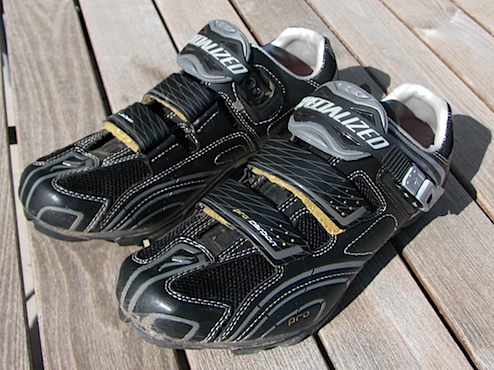
Yes, I am the proud owner of a new set of Specialized BG Pro Carbon MTB shoes. And you know what? They look great, instantly felt comfortable (as I have mentioned, the Specialized Body Geometry fit has always been a strong point with their gloves and shoes), and the product manager told me I talked with said they’ve really been working on their material and construction quality. So I have high hopes for these.
And these shoes are mine to keep — not just test — so I guarantee you I will be checking in from time to time with how these are holding up.
Oh, but that’s not all they sent. Noting that the Specialized BG Ridge gloves I like so much are actually from a season or two ago, Specialized sent me their latest version of the glove:
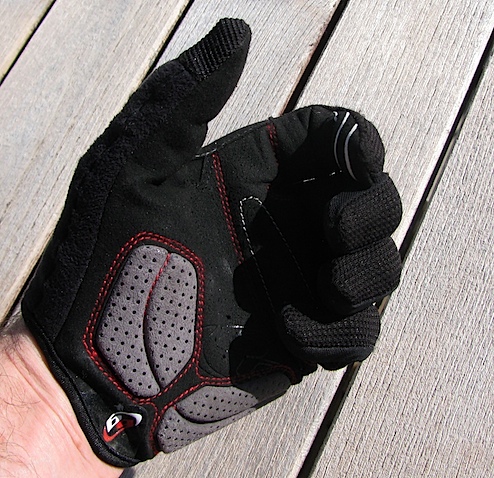
Specialized points out that for this year, the palm padding isn’t as thick, which is true, and also an excellent call. Especially when riding a singlespeed, the thinner pad feels great, while still doing its job.
Something that is also new with this glove that I love is that it doesn’t have any kind of wristband. The glove just ends at your hand. Although it has a perfectly-placed little tab — look at the “bg” logo in the photo above — that makes it very easy to pull these gloves on.
I tell you: you never notice how restrictive a glove’s wristband is until it’s not there anymore. Losing the band was a huge improvement.
These are, seriously, the best gloves I’ve ever had. I wear them for both road and mountain biking.
The Real Surprise
I kinda sorta expected Specialized to get in touch with me. But I didn’t know if anyone else would. Based on the wild enthusiasm shown for Sidi shoes in the comments of my shoe rant, however, I was pretty excited when Sidi did in fact contact me.
Sidi talked with me for about forty-five minutes about what I wanted from a shoe, how shoes fit, and the kind of riding I like to do, and then sent me these:
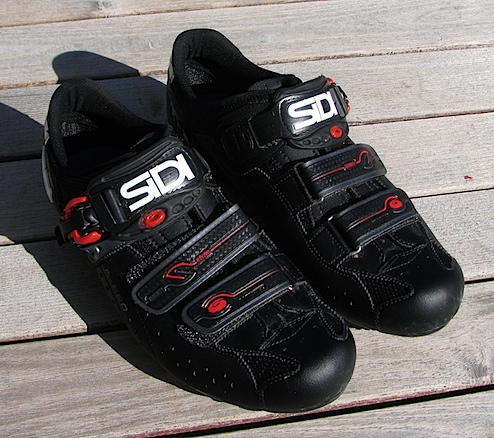
Sidi Dominator 5s. In Mega width, thankyouverymuch. I’m pretty certain these are the second most beautiful shoes I have ever owned. And, so far, they fit comfortably — though the real test will be once I’ve broken them in and taken them out for a five-hour ride.
“But Fatty,” I hear you ask, “If these are the second most beautiful shoes you have ever owned, what — pray tell — are the very most beautiful shoes you have owned?”
Oh, well, that’s an easy question. See, Sidi sent me two pairs of shoes:
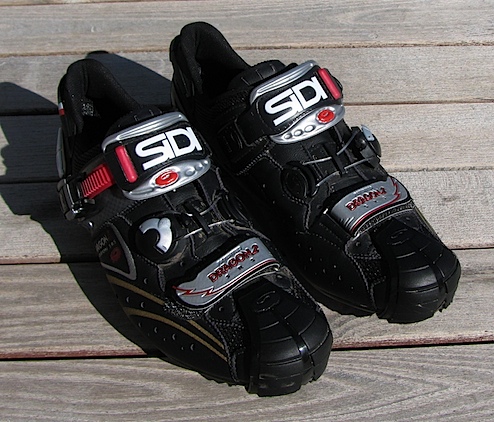
That’s right, I’ve got a pair of Dragon 2 Carbon SRSs. These shoes adjust to fit in a near-infinite number of ways, including how they fit your heels. They came with replaceable toe-guards, so I don’t destroy the shoes when hike-a-biking.
And they smell just like the inside of a brand new Ferrari. Or at least they did when I first got them. I haven’t checked again since taking them out.
Of course, how beautiful they are is not really the most important thing to me, since soon these shoes — even the Dragons — will be permanently covered in dust and mud. Expect to hear more about how each of these shoes fit and hold together over the long term.
Meanwhile, let’s summarize my mountain biking shoe situation as it stands today:
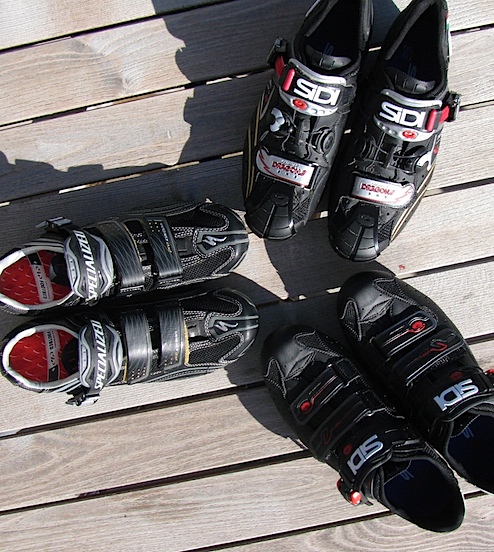
I told you I was going to gloat, didn’t I?
PS: I managed to lose all but the first 8 or so of the comments to this post. Some nights, it is not good to be the Fat Cyclist.
PPS: For those of you who are curious about how I managed to lose all those comments (>50), here’s what happened. Late Friday night I spent about 45 minutes trying to find a way to be able to watch the Giro, without success. It occurred to me that I was kind of like a junkie trying to get find someone to get me a fix, making increasingly desperate calls to get hooked up. So I started writing a post using that premise, then decided it was a one-line joke, not worth a whole post. So I went to delete the in-progress post. But — remember, this is late at night — I clicked the wrong post (ie, the shoe post) in my blog editing tool (Ecto, for those of you who care) without noticing it was the wrong post. pressed Delete, and answered Yes to the question “Delete both online and local versions?” without thinking about why it would ask me to delete the online version of something I hadn’t yet put online. And so then it was gone, comments and everything. Luckily I had an instance of a browser up with my blog entry and a few comments still showing. Using copy and paste, I replicated the post and those comments, and then promised myself I would never post or delete that late at night again.
Comments (29)
« Previous Page — « Previous Entries Next Entries » — Next Page »








